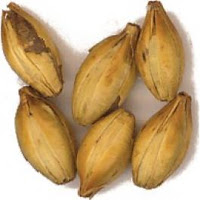AKA don't over-crush your grain...please.
All-grain brewers worldwide are worried about increasing their efficiency. This is not, personally, something I worry about very much, but to some it's the holy grail. Or at least one of the holy grails. The first bit of advice you're likely to get when looking for tips on improving efficiency is to crush your grain finer. Frequently, the art of crushing grain seems to be in how closely to atomizing it you can get. I urge you, dear reader, not to go down this path. Experimenting with crushing grain into smaller and smaller particles can only lead to a micro black hole which will destroy the universe... or possibly a stuck sparge. And a stuck sparge is super annoying.
I can empathize with the urge to increase efficiency, and a poor crush can be problem. Contrary to popular belief, though, the real issue is not coarse crushing, but inconsistent crushing where some amount of malt passes through the mill without being cracked or crushed at all. Grinding everything into dust does guarantee that all the kernels are being crushed, but there is also the potential that crushing your malt into flour will decrease efficiency past a point due to wort absorption. It's not too hard to imagine that flour absorbs more liquid than crushed or cracked grain, and this can make a noticeable difference in efficiency. You can go too far when it comes to crushing grain. The ideal, in this writer's opinion, is to expose the interior of the malt to the mash, without completely destroying the grain itself.
The key is, crush your malt well. Make sure it's being crushed evenly and all or most of the kernels look cracked and uniform. Take a look at the grain as it comes out of the mill. Are the kernels cracked or broken up evenly and into uniform size? If so, give it a whirl. Take specific notes on collected volumes and gravity through out the process, and see where your efficiency lands. If there is no improvement, try crushing finer in increments. And hey, a few points in efficiency is probably worth not having to dump out your mash into another vessel because of a stuck sparge.

I would add one thing: chopping up the husks will increase the extraction of tannins from your grain, which can result in a mouthpuckering astringency that is usually pretty unpleasant in beer. Getting a couple extra efficiency points isn't worth 5 gallons of inferior beer!
ReplyDeleteI am not ashamed to admit I am scared of micro black holes.
ReplyDeleteThere are variables besides crush - pH, time, water/grist ratio - that play big in mash efficiency, and (since the advent of Buffer 5.2) they are arguably easier to adjust.
Plus, few of us have unlimited time in which to brew. In the past year I've come to consider mash efficiency more in terms of time and effort than in ppg ... at some point that extra 0.x% abv's worth of maltose isn't worth the additional y minutes required to eke it out.
Buy a three roller monster mill. then you don't have to worry about destroying the husks. My 1/2 inch drive DeWalt drill runs the mill at full speed and I haven't stuck a sparge in months!
ReplyDeleteI saw an increase of 10% in one batch. I think this was because of a longer mash time. 1 hour vs. 2 hours becaue I was busy with something else.
ReplyDeleteCrush it till you're scared, as in more than you think you should, and that's the point you should start. From there if you need back off the crush a bit great, but that scenario is a rare one. Don't be afraid to crush! As a couple of pro brewers have stated, "crush the he_ _ out of it".
ReplyDeleteAstringents are MUCH more a factor of mash pH than over-crushed barley. The only astringency I've ever encountered in my or other bier has been from over-sparging which lowers the pH too low.
Signed - Phillip the Crushaholic! :)